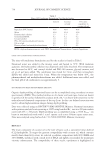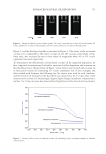725 PHYSICOCHEMICAL PROPERTIES OF TEXTURED HAIR between the two hair types. Possibly, the greater quantity of lipids in tightly curled African hair might facilitate the cutting/slicing procedure, acting as a lubricant between the blade and the fiber. However, if tightly curled African hair had a more developed cortex, should it not be more difficult to slice? In addition to its highly elliptical cross-sectional structure, African hair contains many other geometrical variants of its cross-sectional shape along the length of the fiber. Figure 13 presents a FESEM micrograph where two distinct shapes are represented: one that contains an oval shape with a large, rounded protrusion on its bottom right side (cross- section on the left side of the image) and another that has a more highly elliptical form with a projection on its top right side (cross-section on the right side of the image). These slices were obtained at a point of curvature along the fiber. Kamath et al. report a variety of cross-sectional shapes that are found at the curvature point of the African hair fiber (7). At times, the microtome technique can result in fracture of the cross-sections of hair. This is nicely illustrated in Figure 14A where there are several splits within the cortex. Close examination of Figure 14A reveals a fine structural element that when imaged at higher magnification (Figure 14B) allows us to view macrofibrils grouped together. It is possible that the 3.2 × 2.0 μm feature in Figure 14B is a cortical cell, which is usually 5 μm in diameter and 50 μm in length. Another fracture point image of tightly curled African hair is given in Figure 15. In this example, which is from the cuticle–cortex interface, we can clearly identify the macrofibrils and even melanin granules. The dimensions of the indicated macrofibrils (200 and 420 nm) fall within the generally reported range, which is about 40–500 nm (50–52). Also of interest, the indicated melanin granule in Figure 15 has the dimensions of 883 × 453 nm. Previous studies report melanin granule dimensions on the order of 0.3–0.6 μm in width and 0.8–1.2 μm in length (53). In general, we observed more melanin granules in tightly curled African as compared to Caucasian hair, although this is not a fair comparison because Figure 13. FESEM micrograph of diverse cross-sectional shapes of tightly curled African hair.
726 JOURNAL OF COSMETIC SCIENCE we did not color match the two different hair types by a spectrophotometric technique. In this particular case, our Caucasian hair sample was European dark brown hair, which presumably should contain less melanin granules than tightly curled African hair just based on the color difference. Nevertheless, a more rigorous, quantitative study would be required to make any assumptions about the melanin content of the different hair types. TENSILE PROPERTIES The inherent weakness of textured hair, as compared to straight hair, has led researchers to conduct studies to better understand its mechanical properties and susceptibility to Figure 14. FESEM micrographs of tightly curled African hair showing (A) the overall fiber cross-section at ×1,100 magnification and (B) high magnification view (×6,000) at the fracture point showing one of the structural elements, which appears to contain a number of macrofibrils bound together. Figure 15. FESEM micrograph (×12,000 magnification) of a fractured cross-section of tightly curled African hair at the interface of the cuticle and cortex. Dimensions are provided for two of the many macrofilaments and one of the melanin granules.
Purchased for the exclusive use of nofirst nolast (unknown) From: SCC Media Library & Resource Center (library.scconline.org)






































































































































